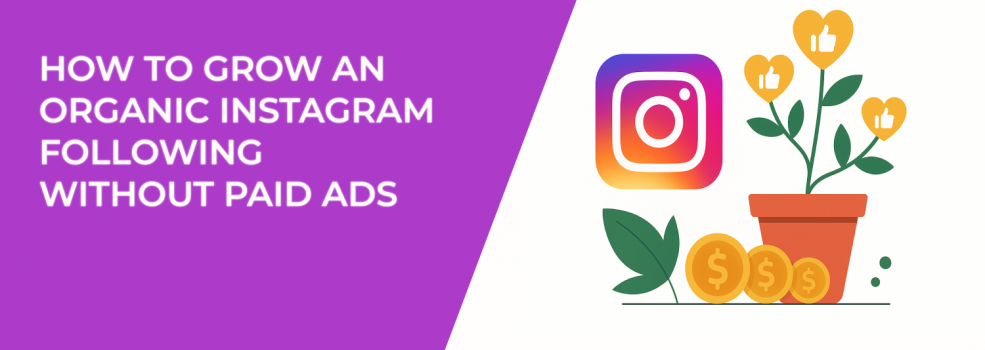Growing on Instagram without using paid ads can feel like shouting into a void — especially when you see competitors skyrocketing with sponsored content. But a well-executed organic strategy can drive long-term growth, build trust, and attract highly qualified followers who are more likely to convert.
Here’s how marketers and advertisers can grow their Instagram presence strategically — without spending a cent on promotion.
1. Craft a Profile That Converts Visitors into Followers
Your Instagram profile isn’t just a bio — it’s a first impression, a pitch, and a conversion tool.
To optimize your profile:
-
Username: Use your business name or a clear version of it (e.g., @brightadsco instead of @wearebright).
-
Profile picture: Use a professional, easy-to-recognize image — such as your logo or a high-quality headshot if you’re a personal brand.
-
Bio: Write one sentence describing what you do, one sentence describing who it’s for, and one line with a call to action. For example:
“Email marketing for e-commerce brands. Tips, templates, and audits. Grab your free checklist below.” -
Link in bio: Use a tool like Linktree, Later, or Beacons to offer more than one destination — blog, lead magnet, booking page, etc.
-
Highlights: Organize your story highlights into clear categories. Examples:
-
“Start Here” → for FAQs or service overviews;
-
“Client Wins” → share case studies or testimonials;
-
“Free Tips” → repurpose educational content from past stories.
-
Tip in practice: Review competitor profiles that are getting strong engagement and borrow structural ideas — just make sure to tailor the messaging to your own niche and brand.
If you're still figuring out who you're talking to, this step-by-step audience targeting guide can help you clarify your Instagram strategy before you ever press “Post.”
2. Build a Content Strategy Around Clear Pillars
Posting randomly might get a like or two. Posting strategically builds a brand.
Start by defining three to five content pillars that align with your audience’s goals and challenges. Then rotate between these themes consistently.
Examples of content pillars for a Facebook Ads consultant:
-
Tips and Tutorials: How to set up A/B testing in Meta Ads Manager.
-
Case Studies: “How this campaign generated a 6x ROAS in 10 days.”
-
Industry Insights: Commentary on the latest algorithm update or Meta’s ad policies.
-
Behind-the-Scenes: Your daily setup, ad creative process, or client onboarding workflow.
-
Personal POV: What you believe about digital advertising that others get wrong.
Tip in practice: Batch-plan content using a simple spreadsheet or content calendar. Schedule a week or month’s worth of posts around your pillars to avoid scrambling at the last minute.
For more inspiration, this article on organic Facebook post ideas shows how strategic content pillars increase engagement — and the same logic applies to Instagram.
3. Use Reels to Teach, Demonstrate, or Challenge
Instagram still pushes Reels more than any other format. But the goal isn’t to go viral — it’s to deliver clarity and value.
To create Reels that work organically:
-
Keep it short (under 30 seconds if possible) — attention spans are low.
-
Add text overlays to summarize the message, especially for mobile users watching on mute.
-
Hook early — start with a bold statement or question like, “Still boosting posts? Here’s why that’s a waste.”
-
Show results — walk through a campaign that worked and how you built it.
-
Use on-screen steps to break things down:
“Step 1: Define your ideal customer. Step 2: Build a custom audience. Step 3: Split-test creative.”
Tip in practice: Repurpose your blog posts, emails, or tweets into video scripts. Don’t overthink visuals — even a quick screencast or face-to-camera video can outperform polished but vague content.
If you're ready to start, take a look at this guide on using Instagram Reels in your marketing strategy — it includes tips for keeping your Reels consistent, brand-aligned, and discoverable.
4. Treat Hashtags and Keywords Like SEO
Instagram has evolved — it’s not just about hashtags anymore. Search functionality now pulls from your bio, captions, and alt text.
Optimize your content for discoverability by:
-
Including niche keywords in your captions (e.g., “lead generation for real estate agents”).
-
Writing descriptive alt text manually — this is an option when uploading posts, and it helps with accessibility and SEO.
-
Using 5 to 10 relevant hashtags, combining:
-
Industry-specific tags (e.g., #ecommerceads, #facebookadstips);
-
Community tags (e.g., #womeninmarketing, #founderlife);
-
Branded or location tags if applicable (e.g., #brightadsco, #miamimarketing).
-
Avoid using the same hashtags on every post — Instagram deprioritizes repetitive behavior.
Tip in practice: Create a few sets of 10–15 rotating hashtags tied to different content pillars. Save them in Notes and tweak them before each post.
5. Build Relationships Through Real Engagement
Engagement isn’t just a metric — it’s currency. Instagram’s algorithm favors accounts that actively participate in the platform.
Here’s how to engage in a way that builds organic visibility:
-
Reply to all DMs and comments — even if it’s just “Thanks for the input, great point!”
-
React to Stories from people you want to connect with — this opens up a chat thread and increases the chances of future collaboration.
-
Leave insightful comments (3+ words) on niche accounts in your industry.
-
Ask real questions in your own captions that invite responses (e.g., “What’s the best result you’ve ever gotten from a cold audience?”).
Tip in practice: Schedule 10–15 minutes per day for active engagement. Don’t just post and ghost — make time to interact like a human.
6. Collaborate With Others — Even If They Have a Small Following
You don’t need influencers with six-figure follower counts to grow. Micro-collaborations work better, especially when they’re aligned with your audience.
Ways to collaborate organically:
-
Co-create a carousel post comparing your approaches on a shared topic (e.g., ad design vs ad copy).
-
Run a joint Instagram Live and answer audience questions together.
-
Trade Stories where you shout out each other’s accounts and explain why you follow them.
-
Create a shared Reel where each person offers one tip — then post it on both accounts.
Tip in practice: Reach out to complementary service providers — not direct competitors. If you run Facebook ads, team up with a creative strategist, CRO expert, or email marketer.
7. Repurpose High-Performing Content from Other Platforms
If you're writing blog posts, newsletters, or even LinkedIn updates, you already have content that can be reshaped for Instagram.
Here’s how to break it down:
-
Turn blog summaries into carousels: Each slide becomes a key takeaway, ending with a CTA.
-
Use newsletter intros as Reel scripts: Tell a short story that builds into a tip.
-
Repost data or charts as infographics or Story slides.
Tip in practice: Use a tool like Notion or Airtable to track all published content. Highlight pieces that performed well on other platforms and adapt them for Instagram every few weeks.
8. Analyze Weekly and Adjust Monthly
Guessing what works leads to wasted time. Instead, use Instagram Insights to track:
-
Reach and impressions — are you being seen?
-
Saves and shares — is the content valuable enough to keep or send?
-
Profile visits and follows per post — are your posts turning into new eyes?
Look for patterns. If your audience saves carousel posts about metrics but skips inspirational quotes, you’ve found a signal.
Tip in practice: Once a month, review your top 5 posts and worst 5 posts. Identify what the winners had in common — topic, format, posting time — and test those patterns again.
If you're doing this across multiple platforms, be sure to unify your organic efforts. You can learn how in The Best Organic Facebook Post Ideas to Drive Engagement, which offers similar insights for content types and engagement metrics.
Final Thought
Growing an organic Instagram following is slower than paying for impressions. But it’s deeper. It’s more sustainable. And when done well, it creates followers who stick around, engage with your brand, and take action — not just scroll past.
Think like a strategist, post like a teacher, and interact like a peer.
Your audience is out there — now it’s your job to earn their attention.

